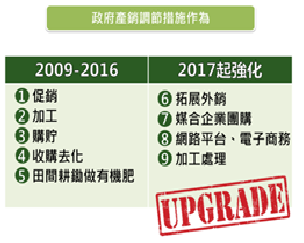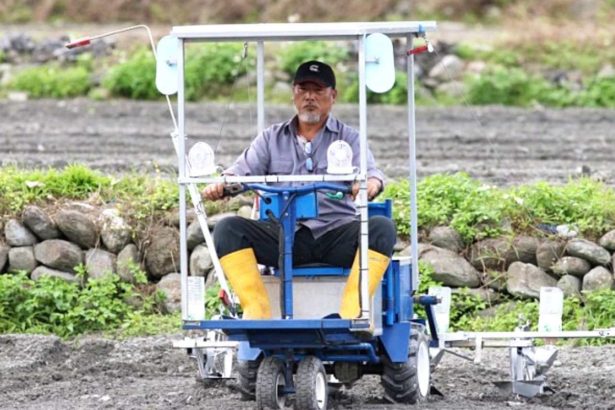Analysis on the present situation of production and Marketing structure of Agricultural products in China and suggestions for improving problems (part I)
Share + 1 Tweet Email
In the past two months, there has been considerable coverage in the social and political news about the collapse of the prices of bananas, pineapples, papayas, dragon fruits and other fruits that have cost farmers all their money. Among them, there are sorrowful appeals and protests from farmers everywhere, explanations made by officials of the Council of Agriculture to defend their own administration and response measures, and incidents in which purchasing traders from places of origin are squeezed out and attacked by the same industry because the purchase prices are too high, and so on.
The phenomenon of skyrocketing and plummeting prices of agricultural products in China actually occurs frequently and irregularly. Whenever an incident occurs, ordinary people are usually deeply impressed by the price increase, because the price in the retail market will be too high for people to buy, while the retail price at the consumer end often has no feeling about the drop in the bumper harvest price. at best, it is back to the normal price or a little cheaper than usual.
However, for farmers, the general reaction is that when market prices rise, the price of the place he can get is not as high as that in the wholesale market, but when prices fall in the wholesale market due to a bumper harvest, it is the beginning of pain. Often there is no way to sell or lose money.
Government units are often blamed for this problem of skyrocketing and plummeting market prices of agricultural products. It seems unfair to say that the government has done nothing on this issue, because the government has long used various subsidies (such as de-marketization of surplus or inferior products) to make up for farmers' losses. or initiate regulatory measures such as the procurement of foreign agricultural products to calm price changes and quell public grievances.
If the Government can respond to such incidents immediately, the disputes will be much smaller, but if the response is too slow, social and political news will be greatly hyped. However, no matter what kind of treatment it is, when the incident calms down, it is usually like a ship crossing the water without a trace, and we can only wait for the next time to deal with it, and the problem seems to be unsolved forever.
Whenever there is a major sharp rise and fall in prices, the Council of Agriculture will put forward some policy posts and measures to deal with them; for example, in this storm, the chairman of the Council of Agriculture, Lin, released a briefing at a press conference on the regulation of fruit production and marketing. (the following picture shows what measures the government has taken in the past to deal with the problem of overproduction and price collapse. But after so many years of problems, it is clear that these measures have not been effective to really solve the problem.


The bottom color box in the picture above shows three types of agricultural producers, including individual farmers, production and marketing classes and production cooperatives; the producers' mode of production includes different types of open-air cultivation, temperature / net room cultivation and plant factories. Basically, in addition to the production types of plant factories, peasant associations will play a certain role of production guidance and coordination of transportation and marketing among these producers.
In line with the norms of the Agricultural products Market Trading Law, there are basically three ways for farmers to sell agricultural products: self-production and self-sale, contract production, independent production and delivery to wholesale markets or specific trading markets. According to different sales channels, in order to meet the special needs of this way, farmers will have different practices in the production and management of agricultural products, and their bargaining power on the price of products will also be different. Naturally, there are differences in the production and marketing environment and problems they are facing, which are described as follows:
Self-production and self-sale:
As shown in the picture, there are four kinds of self-produced and self-selling sales channels: bazaars, peasant association outlets / stores, self-built official websites / e-commerce websites and health (self-owned) restaurants. (other practices such as farmers' own carts to transport products to the market / roadside sales are ignored here.)
Agricultural products sold through this channel, whether fresh products or simply processed products such as sauces and pickles, can be sold as commodities for farmers, who have the leading right to sell, order and negotiate their products. However, this direct / indirect way of selling to consumers requires a certain amount of sales (including product packaging), publicity and manpower and cost input for non-agricultural production, which is not familiar to farmers. Therefore, only some farmers will sell their products through this way, and many farmers who sell their agricultural products will not bet all of their agricultural products on this pipeline, but will usually operate this sales channel with the mentality of part-time sideline.
It is purely self-producing and selling itself; that is, the proportion of farmers who sell all or most of their agricultural products in this way is even less. Usually this kind of farmers will focus on the production of specific agricultural products, operate their own brands, establish the quality reputation of their products, and also have their own websites (official websites) or join electronic bazaar networks that mainly sell agricultural products.
Note: the words such as "proportion" mentioned in this article are not supported by specific statistics, so they are only a conceptual statement. If government departments do not have relevant statistics, they may collect them in the future as a basis for decision-making and management.
Through online marketing, this kind of farmers usually rely on the assistance of professional website operators (such as Odingdine Market) to shape their brand image, expand their online customer base and cultivate a fixed source of customers. More ambitious farmers will join or operate multiple websites at the same time to expand the contact area of online customers, so as to improve the sales volume and speed of products.
On the whole, the proportion of agricultural products and processed products sold through this way in the total sales of agricultural products in the country is very low, so it will not affect the change in the price of agricultural products in the whole country. If farmers establish their own brand and quality reputation, they are less affected by market price fluctuations and can sell products at a better price than in the wholesale / retail market.
Although online shopping has become a trend, agricultural administrative units also encourage farmers and peasant groups (such as peasant associations) to set up websites to sell agricultural products through counseling and subsidies. There are also various commercial website operators who mainly sell agricultural products. However, this type of sales approach is only suitable for specific consumption patterns, specific types of agricultural products, and meet specific types of consumer groups, and can not be promoted as a sales channel to meet the consumption needs and habits of the general public. Even if the development is successful, because of the small size of the market, only minority farmers who invest in advance and continue to operate can benefit. Therefore, the price of agricultural products sold through this way can not affect the daily trading of a large number of agricultural products, nor can it improve the risk of drastic changes in the trading prices of agricultural products per production period faced by most farmers.
Contract production:
"contract production" is a production mode similar to "contract production" or "guaranteed acquisition". As far as the purchaser is concerned, because he must meet the market demand of existing channels or the commercial interests of developing channels, he must find reliable producers of agricultural products and obtain a stable supply of agricultural products to meet the needs of their commercial and service operations. On the other hand, for agricultural producers, because they do not have to worry that they may face the dilemma of no way to sell their agricultural products or a sharp drop in prices in the future, they can reduce the risk of agricultural production and focus on the operation of agricultural production. therefore, the acquisition of contracts for production is a relatively secure mode of production and sales for farmers.
The selling price of agricultural products (place of origin) produced by the contract is basically agreed by both parties in advance. The acquirers will calculate their commercial costs and profits and propose an acceptable purchase price, while the producers will estimate their production costs and expected revenue, propose the expected sales price, and then negotiate between the two parties. The ideal price agreement will determine the purchase price range on the basis of certain product quality, that is, a flexible pricing scheme will be adopted depending on the quality of harvested agricultural products and the wholesale market price at that time; however, the maximum will not be higher than a few yuan, and the lowest will not be less than a few yuan. As to whether this price is better for farmers, the leading power of negotiation is mostly in the hands of the purchasers.
As the acquirer will operate a considerable amount of end-market demand, so his cooperation with contract production is usually based on production and marketing classes and production cooperatives, and seldom sign contracts with individual farmers. However, because some purchasers still take profit as the main consideration, and farmers will also be attracted by the occasional high profits of other farmers, stable and popular contract production relations need to be further cultivated. Government departments should play a certain role in it.
Although the quantity of agricultural products released by contract production is obviously higher than that of self-production and marketing, and because of a certain sales model and production and marketing order, the price fluctuation of agricultural products sold on this channel is obviously lower. As shown in the figure above, because its sales channel has low overlap with that of the wholesale market and is still unable to compete with the wholesale market in quantity and variety; in most cases, its product attribute is also different from that of the wholesale market, and the unit price is likely to be higher than the average price of the wholesale market; therefore, the product price of this channel can not significantly affect the price and price changes of the wholesale market. At best, when the retail market prices of agricultural products soar unreasonably, the agricultural administration units will use both hard and soft methods to persuade the big stores to increase the shipments of their production areas to slightly balance the soaring prices of agricultural products.
From the above analysis, we can see that deed production is a production mode that is more secure to farmers and can produce a good relationship between production and marketing. Agricultural administrative units should consider how to effectively expand the development of deed production mode and guide the wholesale market to open up the trading environment for such products or induce wholesale market purchasers (zero wholesalers) to purchase agricultural products from deed production suppliers. At the beginning of the year, the Council of Agriculture, the Ministry of Health and Welfare, and the Ministry of Education promoted the need for school nutritious lunch materials to comply with the "four chapters one Q" policy based on food safety needs, which is an excellent policy to improve the environment for agricultural production, sales and procurement. Agricultural administrative units can further track the changes in the impact on the contract production environment under this policy and find out whether the two sides have established a healthy contract production cooperation model.
Independent production and delivery to wholesale market for sale
Every time we talk about the sudden rise and collapse of the prices of agricultural products, the source of the incident is actually the trading prices in this wholesale market. In particular, the daily wholesale prices in Taipei's first and second cities of agricultural fruits and vegetables have an obvious effect on guiding price changes in the retail market.
In the 1960s and 1970s, the Agricultural products Wholesale Market was established through the Agricultural products Market Trading Law, whose original purpose was to establish a unified and open trading environment and order for agricultural products throughout the country. to avoid uneven regional arrival distribution and unfair trading due to artificial monopoly or information gap and other factors, resulting in unreasonable prices of agricultural products, so that the purchase price of the place of origin is exploited by middlemen.
This system has been in place for many years, and the transparency of transaction information has become rapid and sophisticated with the help of the development of information technology, but there is no sign of a slight slowdown in the frequency and drastic changes in the prices of agricultural products. In addition, it is still common to hear farmers complain that they do not get corresponding benefits when prices rise in the wholesale market, while when prices plummet, they lose a lot of money. The role of government departments here also appears to be extremely passive and awkward, neither does it have the coercive power to restrain the price changes of agricultural products, but it has to bear the scolding of both farmers' producers and end consumers when agricultural prices rise or plummet, spend a huge amount of public money, make efforts to clean up the mess, and the cycle seems endless.
To explore the reasons for the sudden rise and collapse of agricultural prices in the wholesale market can be attributed to the imbalance between supply and demand (abundance or disaster loss and shortage) caused by seasonal and climatic factors. However, looking at the relevant materials and information, it is not difficult to find that there are also problems worth discussing in the whole agricultural production and marketing transaction chain of our country.
Mr. Lin Yuyi, who has long been concerned about China's agricultural production and marketing, and Mr. Jiao Jun, another columnist who is both a farmer and columnist, have pointed out some problems in many articles. For example, in the wholesale market, suppliers / tradesmen and underwriters may influence the operation of wholesale price, the behavior of exporters in compressing the purchase price of farmers in the producing area, the phenomenon that the production and marketing mechanism of the wholesale market can not effectively link the purchase price with the market price, and the appeal for continuous review and improvement of China's transportation and marketing system and structure.
In addition, from the news incident that banana trader was beaten in June this year, it can also be seen that there are hidden rules of the so-called industry in this field of agricultural product acquisition. When people fail to abide by this rule and affect the interests of others, they will be excluded or even attacked; and this hidden rule is not conducive to producers (farmers) to get the profits they deserve.
Therefore, if the agricultural administration authorities want to change the role of being passively beaten everywhere, they need to actively face the problems, take effective measures to gradually improve the production and marketing structure and physique of our country, reduce the price fluctuation of agricultural products, and improve the income that farmers should get.
How do I do that? Let's make it clear in the next paragraph.
Share + 1 Tweet Email
- Prev

Solar seeding car is super strong! Fuel-free zero-carbon row, sitting without basking in the sun, can cultivate four hectares a day
Solar seeding car is super strong! Fuel-free zero-carbon row, sitting without basking in the sun, can cultivate four hectares a day
- Next

[Sicily. Bullets. Spaghetti with tomato sauce]
[Sicily. Bullets. Spaghetti with tomato sauce]
Related
- A course of planting techniques and methods on how to grow carrots
- How to plant the latest tulips?
- Is it better to pick tea in the morning or in the afternoon? When is the best time for tea to be picked? what is the third or fifth tea?
- Launch Yuanxiao Happy combination Haocha + Tea Yuan healthy Taste
- Penghu Tourism "Fireworks 20 Parade with You"
- 2022 West Lake Happiness holds "Digital Revitalization Voucher" and draws iphone13 and laptop.
- Banqiao Fuzhou social houses are designed to change start-up combined with police elimination to create a safe and livable environment
- The convenient measure of "mechanical weeding" in Xinbei has been abused and the Agriculture Bureau has imposed heavy penalties on the illegal land consolidation.
- Changgeng University Joins Hands with Four Memory Factories to Rescue Memory Talent Shortage
- The list of Taiwan's top 100 MVP managers is listed by the Director-General of the Farmers' Association of Sanxia District.

